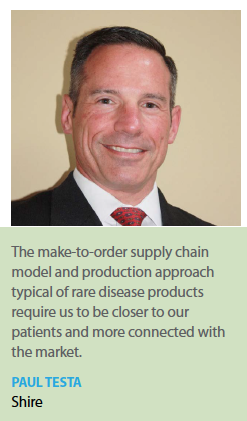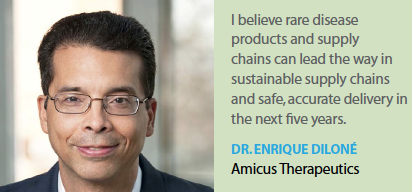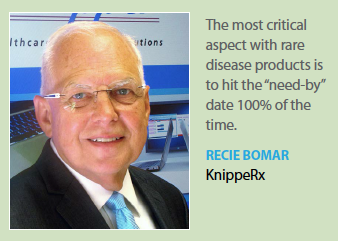Collectively, about 7,000 different types of rare diseases affect around 350 million patients globally. A disease is considered rare if it affects fewer than 200,000 people in the United States or one in 2,000 people in Europe, but the burden such diseases place on patients, communities, and healthcare systems is vast.
 Today, a growing number of companies are developing orphan drugs for rare diseases, but one particularly complex aspect of managing rare diseases is ensuring the therapy gets to these geographically dispersed patients in the dose needed, at the right time, and in the right setting.
Today, a growing number of companies are developing orphan drugs for rare diseases, but one particularly complex aspect of managing rare diseases is ensuring the therapy gets to these geographically dispersed patients in the dose needed, at the right time, and in the right setting.
Because rare disease products are typically of much smaller quantities — both in terms of patients as well as the number of doses handled — it’s often necessary to support a make-to-order supply chain model and production approach, says Paul Testa, head of supply chain for Shire.
While the volume of patients for each rare disease is reduced, the geographic coverage is often broader than traditional markets, says Tony Street, senior director of clinical trial supplies and logistics at Parexel.
Dealing with Logistics Challenges
While many of the challenges for the rare disease supply chain are similar to those of traditional pharmaceutical supply chains, the specialized nature of rare disease treatments means orphan drugs face some unique logistical challenges.
For example, Shire’s Mr. Testa says the small size of the patient population often requires the company to make fewer batches of smaller batch sizes.
“These considerations make advanced and precise planning much more of a priority in the rare disease arena," he says. “Further, scenario planning is often more important in rare diseases, as flexibility of product supply can be constrained for clinical trials or launch preparation."
According to Enrique Diloné, Ph.D., senior VP, technical operations, Amicus Therapeutics, traditional supply chain models that support multiple hand-offs and touch points don’t work for rare disease products.
“Instead we approach the supply chain design from scratch," Dr. Diloné says. “We start with the patient and work upstream through the supply chain, focusing on service and agility as the patient numbers are small. Any deviation in demand normally will impact the supply chain, so, building in late-stage customization and flexibility is a key element. The challenge is doing this in a cost-effective manner."
 The ability to adapt manufacturing capacities to match the supply versus demand is key, Dr. Diloné says.
The ability to adapt manufacturing capacities to match the supply versus demand is key, Dr. Diloné says.
“We truly need to understand the disease and treatable population size as finding an additional, for example, 1,000 patients could mean doubling capacity and for a complex product this may not be a quick turnaround," he says.
As high-value, temperature-controlled products, orphan drugs require cold chain logistics, especially when transported through climates accustomed to extreme weather conditions, says Doug Cook, president of global specialty logistics at AmerisourceBergen.
“The demand for temperature-controlled logistics is compounded by the fact that individual market demand is often difficult to predict and most patients are dispersed geographically, or centered within specific geographical areas and populations," he says. “Further, orphan drugs are produced in small quantities and can be very expensive to develop and manufacture, so any degree of damage or spoilage can be a major issue."
With a wide geographic reach, traditional batch runs of packaging and labeling leads to significant product waste, which is why it’s important to manage localized, late-stage customization or just-in-time labeling, Mr. Street notes.
Another logistical challenge with rare disease products in the global supply chain is the potential for delays due to import or export issues.
“Therefore, investment in global trade compliance is time, effort, and money well spent," Mr. Street says.
Mr. Cook says a common problem is that manufacturers often don’t engage their logistics partners early enough in the process to quickly identify efficiencies that could increase speed to therapy for patients. Orphan products require an integrated, customized supply chain that aligns with the manufacturer’s commercialization strategy.
Regulatory challenges also must be taken into consideration. The Food and Drug Administration (FDA) demands robust data collection for rare disease products with regard to their clinical effectiveness, which places the onus on distributors to collect both operational and clinical data to support the manufacturers’ needs, says Recie Bomar, general manager of KnippeRx, a specialty pharmacy, and part of J. Knipper and Company.
 Gerri Treacy, head of Midwest operations for J. Knipper and Company, says manufacturers typically have a schema for how the drug delivery should be managed as a function of FDA approval. Partners to these manufacturers are given a road map to follow, and key performance indicators surrounding proper management are measured to compliance.
Gerri Treacy, head of Midwest operations for J. Knipper and Company, says manufacturers typically have a schema for how the drug delivery should be managed as a function of FDA approval. Partners to these manufacturers are given a road map to follow, and key performance indicators surrounding proper management are measured to compliance.
Personalized Approach
Mr. Testa says the nature of rare disease therapies requires Shire to be closer to its patients and more connected with the market to enable supply assurance and maximize value for patients.
“If a patient needs to travel, it is often not practical to provide supply in a sufficient quantity for the duration of that trip," he says.
“Flexibility of delivery location and administration of treatment for that patient presents a unique supply chain challenge, in addition to any licensure or permit requirements that might exist. We create a customer logistics and delivery solution on a patient-by-patient basis when required."
Temperature and location tracking become increasingly important in complex formulations, and even more so in personalized medicines, where the loss of product can be devastating to both the supply chain and the patient, Mr. Street says.
To combat some of these challenges during clinical trials, Mr. Cook says clinical researchers may choose to have medications stored at a patient’s home to reduce the risk of damage in transit and to make drug administration more convenient.
“Manufacturers may turn to a partner that can provide the logistics and capabilities needed to distribute and manage supply in the unpredictable environment of the patient’s locale, using home trial support and ancillary services such as on-site nursing," he says.
Mr. Bomar says a high-touch model is needed to help with a variety of patient needs: financial assistance, side-effect management, outbound calls to validate adherence, and coordination of adjunctive services along with drug delivery.
“Site of care is also different as these products are dispensed not at a retail pharmacy, but from specialized pharmacies or the physicians’ practice," he says. “By having manufacturers select preferred partners to dispense their drugs, these select pharmacies can provide personalized care and assist with patient compliance."
“We also focus on shortening the overall supply chain with the goal to minimize touch points from product release to the patient," Dr. Diloné says. “Then we need to ensure the highest possible level of service as we don’t have the buffers of inventory at different hold points."
Given the nature of rare diseases, coordination of care is the goal versus just logistical deliveries, Mr. Bomar says.
“The provider must use a multi-disciplinary team to complete these tasks," he says. “Pharmacists and pharmacy  technicians need to verify the prescription and the dosing schedule with the prescribing doctor. Financial coordinators must verify payer eligibility and obtain authorization for the treatment episode. Nursing staff have to educate the patient and caregivers, and help manage side-effects and disease progression."
technicians need to verify the prescription and the dosing schedule with the prescribing doctor. Financial coordinators must verify payer eligibility and obtain authorization for the treatment episode. Nursing staff have to educate the patient and caregivers, and help manage side-effects and disease progression."
Dr. Diloné says a holistic view of the supply chain and the integration into the business with active input and engagement from stakeholders such as healthcare professionals and patient groups is important.
“Clearly striving for deliveries to the patient’s home — where appropriate — and providing support to the patient is where we want to go," he says.
Mr. Bomar adds that connecting the patient to a local disease advocacy group can also bring in much needed support.
In light of such a highly specific model, a specialized distributor is needed — one that also includes the patient perspective through inclusion of patient advocate consortiums as well as input from HCPs and other relevant sources, he says.
Mr. Cook agrees that including patient advocacy groups is crucial, noting for example that in 1950 the Muscular Dystrophy Association (MDA) began advocating for cures for various neuromuscular diseases.
“Since its founding, MDA has funded research and clinical trials for a number of rare diseases, including Emery-Dreifuss muscular dystrophy, ZASP-related myopathy, and Walker-Warburg syndrome," he says. “Logistics partners can work with stakeholders to ensure all groups are engaged and participating in the clinical-to-commercial process to facilitate access."
Mr. Testa agrees developing and maintaining close relationships with all aspects of the healthcare delivery chain for rare disease patients, including healthcare providers, payers, channel partners, and patient advocacy groups is important.
“These relationships allow us to understand and act upon specific challenges that our patients experience and concerns that face our other constituents," he says.
Achieving Secure Delivery
For orphan products, the supply chain needs access facilitated for patients, cold-chain capabilities, and the ability to capture actionable data from clinical trials through specialty pharmacy distribution, Mr. Cook says.
“Accessibility is a commercialization differentiator so savvy manufacturers begin evaluating their channel strategies with their distribution partners at least two years pre-launch," he says.
 Given the complex nature of rare diseases products and the needs of the patients, it’s critical that products hit their need-by date 100% of the time. For this to happen, all the accompanying aspects associated with that treatment episode must also be concurrently completed, Mr. Bomar says.
Given the complex nature of rare diseases products and the needs of the patients, it’s critical that products hit their need-by date 100% of the time. For this to happen, all the accompanying aspects associated with that treatment episode must also be concurrently completed, Mr. Bomar says.
“Benefits and eligibility must be verified; prior-authorization must be obtained; financial assistance needs to be coordinated; and shipments need to hit the need-by date as prescribed."
Dr. Diloné says demand management needs to adapt to the sensitivity of the demand change and always react to changes.
“In addition, customer service and order management need to be focused on quick turnaround and follow up to ensure excellent service levels," he says.
Advanced technology solutions play an essential role in the rare disease supply chain, Mr. Street notes.
“For example, in the clinic supply chain, randomization and trial supply management (RTSM) controls the initial and re-supply algorithms coupled with active temperature and quality status management," he says. “This technology allows for proactive oversight of products during transit, ensuring product and supply chain integrity."
Mr. Street notes that with rare disease products it’s important to achieve the right balance of effort, technology and cost, versus the commercial viability of the product.
“Robust supply chain risk assessment can be used to determine key areas of risk, acceptable levels of risk and appropriate  levels of mitigation," he says. “In addition, greater collaboration across organizations would also make it possible to lower the overall cost of the rare disease supply chain through shared learning and standardization."
levels of mitigation," he says. “In addition, greater collaboration across organizations would also make it possible to lower the overall cost of the rare disease supply chain through shared learning and standardization."
Continuous improvement processes are key, Ms. Treacy says.
“Distributors of rare disease products are striving to discover better, faster, and more cost-effective means of managing the supply chain and delivering these lifesaving drugs to the patients who need them," she says.
Dr. Diloné says in future, standard practices may include working with shortened supply chains with limited touch points to ensure a chain of control, coupled with serialization and smart phone applications which could allow verification at the point of use.
“We would be able to ensure not only the secure supply chain but also a sustainable one," he says. “We would minimize unnecessary product movements and inventory." (PV)
~~~~~~~~~~~~~~~~~~~~~~~~~
Finding an Integrated Solution to the Supply Chain Conundrum
A hospital in Canada sought urgent treatment for a very sick baby two days before Christmas. The treatment had not yet been approved by Health Canada, adding to the logistics challenges. However, within 24 hours, Health Canada had approved the medication’s transport.
The next challenge was getting the treatment to the patient quickly and effectively, says Doug Cook, president of global specialty logistics, AmerisourceBergen.
“With no flight routing options available to ensure formal customs requirements were met, ICS, part of AmerisourceBergen, and World Courier executed a driver-to-driver relay to get the medication delivered the next day clearing customs at the land border," he says.
This example underscores the importance of tapping into a network of resources, business unit partners, or collaborative partners to manage the logistics challenges of delivering therapies for rare diseases.
According to Paul Testa, head of supply chain for Shire, supply assurance is an objective in many organizations; the difference in rare diseases is the impact of poor reliability is much more severe.
“So, we work to deploy a continuous improvement mindset, to ensure that we can respond and overcome challenges as they arise," he says. “Further, a culture of learning is critical — as the challenges increase with every product launch and every delivery expectation. This agile, learning mindset is important as we lead the fight against rare disease and deliver for our patients."


















